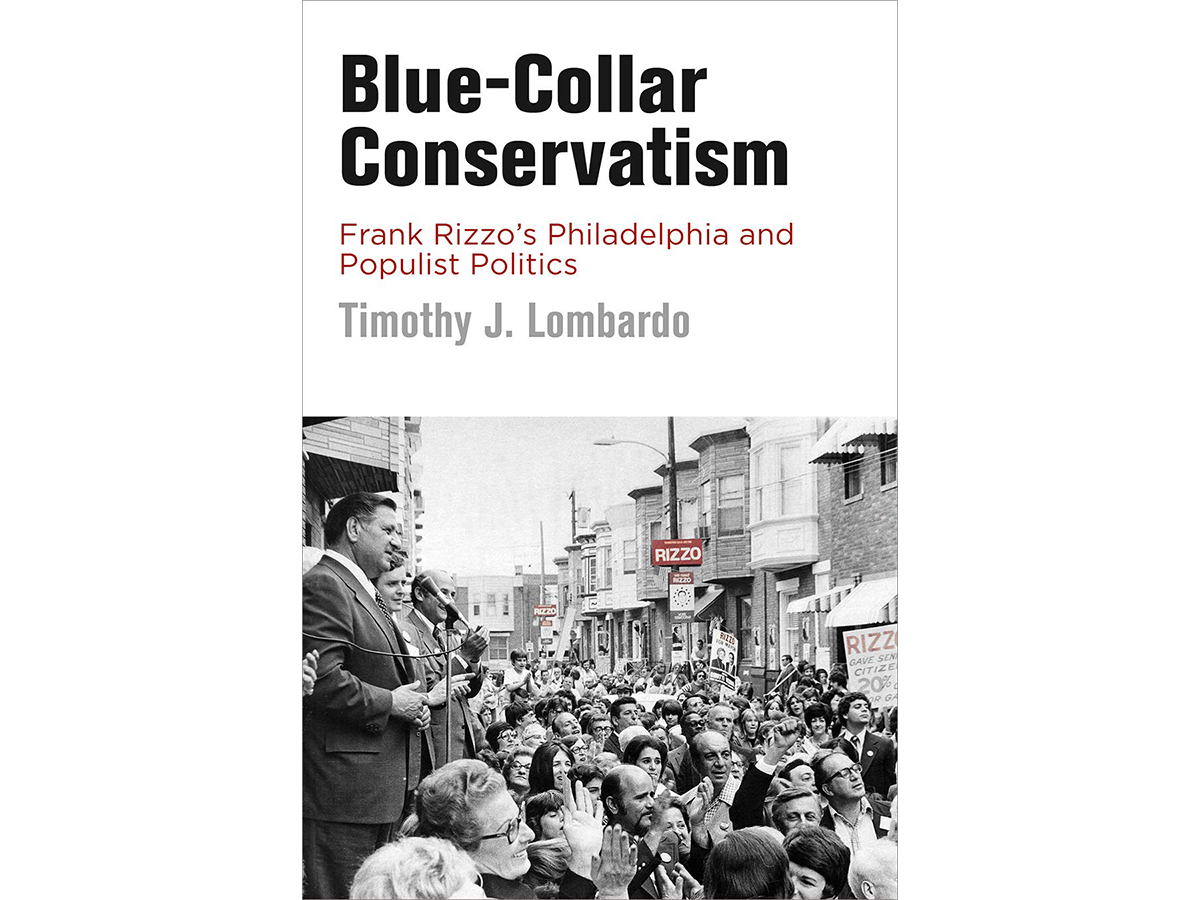Nearly thirty years after his death, Frank Rizzo, Philadelphia’s police chief from 1967 to 1971 and its mayor from 1971 to 1979, remains a divisive figure. A statue of Rizzo remains firmly planted across from City Hall despite protests and support for its relocation from a number of elected officials. A South Philadelphia mural of the former mayor has been vandalized with graffiti protesting the treatment of black Philadelphians by the city’s police. To some, however, Rizzo remains a hero who did everything in his power to serve and protect the city’s residents. Historian and native Philadelphian Timothy J. Lombardo contextualizes and explains Rizzo’s political career and his supporters’ motivations in his 2018 book Blue-Collar Conservatism: Frank Rizzo’s Philadelphia and Populist Politics.
Lombardo argues that Rizzo cultivated support among Philadelphia’s white ethnic residents, many, but not all, of whom were employed in blue-collar trades, by opposing public housing, busing to achieve school integration, affirmative actions, and other policies that benefitted people whom these “blue-collar conservatives” considered undeserving nonwhites. Rizzo’s base was not entirely composed of people who worked in blue-collar professions, but the vast majority of his supporters felt they shared a blue-collar identity built on manual labor and the myth of puling themselves up by their bootstraps, even if they were employed in a white-collar job and had benefitted from government assistance from programs like the GI Bill. This blue-collar identity was also wrapped up in a vision of masculinity closely associated with violence and power. Rather than frame this identity and political perspective as a backlash to civil rights achievements for African Americans, women, and the LGBTQ community, Lombardo argues that it stemmed from the changing nature of postwar American cities.
As Lombardo shows, despite claiming that they had achieved their status through hard work alone, these blue-collar conservatives supported policies like federally guaranteed home loans, but only for groups they felt were deserving—white ethnics like themselves. In the face of what these white Philadelphians felt were threats to their economic standing, they aimed to protect the privileges they had acquired by opposing other groups’ attempts to acquire similar government-backed support. Rather than explicitly state that they opposed government aid to nonwhite Americans, these blue-collar conservatives adopted a color-blind language to support their views. As Lombardo explains, however, “their ability to claim race was unimportant to them was a result of their privilege to ignore it.”
Much of Blue-Collar Conservatism explores housing in Philadelphia and white-ethnic residents’ attempts to differentiate their neighborhoods from majority-black ones. Lombardo analyzes these white ethnics’ efforts to prevent black Philadelphians from moving into “their” neighborhoods, sometimes by violently opposing newly arrived black neighbors. That violence was at least tacitly endorsed by the city’s police, themselves a pillar of support for Rizzo and central to the idea of blue-collar conservatism that Lombardo explores. Because white Philadelphians largely prevented black Philadelphians from moving into white neighborhoods, they could use color-blind language that centered around neighborhoods to maintain segregation in union jobs and in schools as well.
On the backs of these blue-collar conservatives, Frank Rizzo was elected mayor in 1971 and was reelected in 1975. His popularity was far from universal in his own day though. Rizzo’s electoral downfall began in 1978 when he supported changing the city charter to allow mayors to serve a third consecutive term. Even with Rizzo campaigning intensely for the charter amendment, voters opposed the proposition by a two-to-one margin.
Lombardo argues that Rizzo was supported overwhelmingly by people who lived in South and Northeast Philadelphia, but does not provide detailed voting breakdowns to show how much support he received in other sections of the city, nor whether support from residents of those two sections of Philadelphia was sufficient to win elections. Given that Rizzo made his home in a palatial mansion in Chestnut Hill—as far from South and Northeast Philadelphia as you can get—one wonders about the role of his immediate neighbors in his rise and fall.
After four years out of office, Rizzo was eligible to run for mayor again in 1983 and ran in the Democratic primary. As Lombardo shows, he still received tremendous support from South and Northeast Philadelphia, but that was insufficient to defeat Wilson Goode, who went on to become the city’s first black mayor. The same was true in 1987 when Rizzo challenged the then-incumbent Mayor Goode in the general election by switching his party affiliation—something had changed. Rizzo’s failures in 1978, 1983, and 1987 suggest that when he won in 1971 and 1975, he had support from sections of the city beyond South and Northeast Philadelphia because when he only had support from those sections of Philadelphia, he lost.
Lombardo’s excellent and important analysis of Frank Rizzo and Philadelphia does more than shine light on the city’s recent past; it also helps to explain the rise of contemporary “law and order” politics. Lombardo sees the vestiges of Frank Rizzo’s political support in debates over welfare, criminal justice, populism, and perhaps most notably in the support of the current President of the United States.

Seth S. Tannenbaum is Visiting Scholar and Adjunct Professor in the Department of History at Drexel University. He is a lifelong Philadelphian who earned his Ph.D. in history at Temple University. His manuscript in progress is titled Ballparks as America: The Fan Experience at Major League Baseball Parks in the Twentieth Century. His work has appeared in the Washington Post, Sport in American History, and a number of edited volumes and academic journals. Seth can be found on twitter @SethSTannenbaum.
